Horticulture
is
small scale, low intensity farming. This subsistence pattern involves at least part time planting and tending of domesticated food
plants. Pigs, chickens, or other relatively small domesticated animals
are often raised for food and prestige. Many horticultural societies
supplement their farming subsistence base with occasional hunting and
gathering of wild plants and animals. Horticulturalist population densities are
higher than those of most foragers and pastoralists. Usually, there are at least 1-10 people per square mile with
community sizes ranging
from around 30 to several hundred. In most cases, horticulture is
more productive than foraging (with the exception of aquatic foraging).
Some horticulturalists are not only subsistence farmers but also produce a
small surplus to sell or exchange in local markets for things that they cannot
produce themselves.
 |
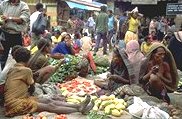 |
|
|
Pigs raised for food and
sale on a |
Women from a
Papua New Guinea |
Horticulture is
still practiced successfully in tropical forest areas in the Amazon Basin
and on mountain slopes in South and Central America as well as low population density areas of
Central Africa, Southeast Asia, and Melanesia
![]() . In the past, it was a common
subsistence base elsewhere in the world until population densities rose to
high levels and people were forced to develop more intensive farming methods.
. In the past, it was a common
subsistence base elsewhere in the world until population densities rose to
high levels and people were forced to develop more intensive farming methods.
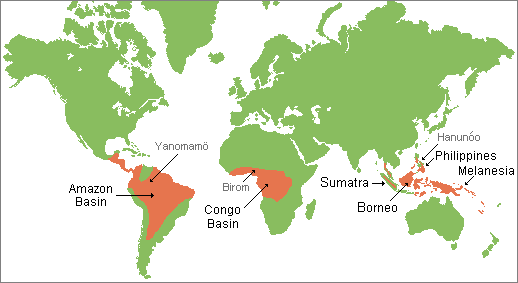 |
|
Major horticulturalist regions during the 20th century |
Horticulturalists usually have a shifting pattern of field use. When production drops due to the inevitable depletion of soil nutrients, horticulturalists move to a new field or a long fallow one to plant their crops. They clear the wild vegetation with a slash and burn technique. Brush and small trees are cut down and allowed to dry out in place. They are then burned. This simultaneously clears the field of all but large trees and adds ash to the soil surface. The ash acts as a fertilizer. No other fertilizer is applied to the field. As a result, soil productivity lasts only for a few years.
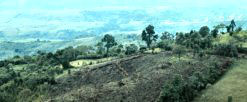 |
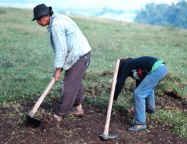 |
|
|
Hillside field in
Colombia cleared of |
Colombian
horticulturalists using |
Horticulturalists do not have large beasts of burden to pull plows. Likewise, they don't have mechanized farming equipment such as tractors or rototillers. They use pointed sticks, hoes, or other hand tools to make holes in the soil to plant their seeds, tubers, and cuttings. This is a labor intensive but not capital intensive form of farming. Pesticides and herbicides are not used by traditional subsistence horticulturalists. Likewise, irrigation is rarely used.
Like
pastoralists, many horticultural societies in the past carried out periodic inter-village
raiding in which people were killed. The goal was usually revenge for perceived
wrongs and, at times, the theft of women, children, dogs, and other things of
value. The horticulturalists of New Guinea and the Amazon Basin were
particularly interested in raiding their neighbors. The Yanomam÷
![]() of
Venezuela and Brazil are one of the most well documented aggressive
horticultural peoples. The ethnographer Napoleon Chagnon reported that
in the past
as many as 1/3 of Yanomam÷ men died of injuries acquired in raids.
of
Venezuela and Brazil are one of the most well documented aggressive
horticultural peoples. The ethnographer Napoleon Chagnon reported that
in the past
as many as 1/3 of Yanomam÷ men died of injuries acquired in raids.
Misunderstandings
about Horticulturalists
People in the industrialized nations with advanced intensive agriculture have for a long time had a distinctly ethnocentric model of farming. When indigenous horticultural societies were encountered, they were assumed to be relatively unproductive and ignorant of soils and plant nutrients. Slash and burn field clearance practices were seen as being destructive of the environment. In fact, the knowledge and farming skills displayed by indigenous horticulturalists often has been surprisingly detailed and practical with regard to soils, plants, and cropping techniques.
 |
|
|
Hanunˇo men |
|
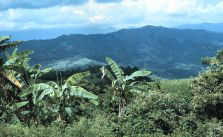 |
|
| Many different food crops
growing together in the same Colombian farm plot (big leafed banana plants provide shade for the more sun sensitive crops) |
In the early
1950's, the Hanunˇo
![]() mountain people of Mindoro Island in the Philippines were
studied by the ethnographer Harold Conklin. These horticulturalists recognized 10
principle and 30 derivative soil categories. They also understood the
suitability of each soil for their crops as well as the effects of erosion and over-farming. They distinguished 1500 useful plants
including 430 cultigens and they identified minute differences in plant
structures. All
of this detailed knowledge was unexpected among horticulturalists. The Hanunˇo
usually grew as many as 40 different crops in the same
field. As a result, their vegetable gardens looked more like a tangle of wild vegetation than
our modern rows of crops. This multi-cropping allowed them to have
successive harvests throughout the growing season, while the dense vegetation
of their crops broke the
erosional force of rain and shielded delicate plants from the sun.
mountain people of Mindoro Island in the Philippines were
studied by the ethnographer Harold Conklin. These horticulturalists recognized 10
principle and 30 derivative soil categories. They also understood the
suitability of each soil for their crops as well as the effects of erosion and over-farming. They distinguished 1500 useful plants
including 430 cultigens and they identified minute differences in plant
structures. All
of this detailed knowledge was unexpected among horticulturalists. The Hanunˇo
usually grew as many as 40 different crops in the same
field. As a result, their vegetable gardens looked more like a tangle of wild vegetation than
our modern rows of crops. This multi-cropping allowed them to have
successive harvests throughout the growing season, while the dense vegetation
of their crops broke the
erosional force of rain and shielded delicate plants from the sun.
Multi-cropping is a common horticultural practice. Mesoamerican horticulturalists carefully plant corn, bean, and squash seeds in the same hole. As the corn stock grows up, it provides support for the climbing bean plant. The squash grows over the ground and keeps down the weeds.
Another example
of the practical farming knowledge of horticulturalists was found among
the Birom
![]() people of the Jos Plateau in north central Nigeria. An
important food of the Birom was the tiny seeds from a grass that they called acha. This cereal crop was traditionally grown in fields without the
use of added fertilizers. During the first half of the 20th century when
Nigeria was still a British colony, colonial officials concluded that the Birom
were ignorant of the effects of fertilizer because they did not put manure
on their fields. In fact, the acha crops failed when the Birom were
induced by government officials to fertilize them. Acha grows too quickly in enriched
soils, falls over from its own weight, and rots before its seeds are
ripe. Following this failed experiment, the Birom were allowed to return
to their traditional farming practices.
people of the Jos Plateau in north central Nigeria. An
important food of the Birom was the tiny seeds from a grass that they called acha. This cereal crop was traditionally grown in fields without the
use of added fertilizers. During the first half of the 20th century when
Nigeria was still a British colony, colonial officials concluded that the Birom
were ignorant of the effects of fertilizer because they did not put manure
on their fields. In fact, the acha crops failed when the Birom were
induced by government officials to fertilize them. Acha grows too quickly in enriched
soils, falls over from its own weight, and rots before its seeds are
ripe. Following this failed experiment, the Birom were allowed to return
to their traditional farming practices.
Economic
Advantages of Horticulture
Horticulture is particularly well suited to humid, tropical conditions. In such environments, temperatures and rainfall are usually high, there are no cold seasons, and plants usually grow vigorously year round. In these areas, nutrients are mainly locked in growing plants rather than in the soil. Energy cycles through the food chain rapidly. Plants flourish, die, quickly decompose, and the nutrients are taken up by growing plants. When forestry product corporations in tropical regions cut down the trees and haul them off for lumber, they remove most of the nutrients leaving the soil impoverished. In addition, clear cutting tropical forests exposes the soil to rainfall and intense sunlight. As a result, the organic components are leached out and the soil erodes away leaving a waste land.
In contrast, horticulturalists usually leave the big trees in place in and around their farm plots. Tree roots help to stabilize the soil. Burning the other wild vegetation converts chemical compounds locked in the plants to a form that is readily useable by their food crops. Planting many different species in the same field assures that the soil remains covered with vegetation throughout most of the year. This protects it from erosion. When the labor input rises to an unreasonable level in a few years, the farm plot is abandoned and allowed to revert to the original natural vegetation again. The decline in productivity is usually due to a combination of the loss of nitrates and potassium from the soil as well as growing competition from weeds and insect pests.
 |
|
|
Colombian
horticulturalist |
Most temperate zone intensive agricultural techniques are generally inappropriate for tropical forest areas. Plows expose too much soil to the elements. Massive amounts of fertilizer must be added to the soil regularly due to the leaching effect of heavy rain fall. Because mono-cropping is the usual practice with this kind of agriculture, the crops are often more susceptible to being wiped out by insects, fungal infections, and other parasites. As a result, pesticides and herbicides must be heavily used. Large domestic animals for pulling plows and wagons are often restricted in the tropics by insect-borne diseases. This is particularly true of Central Africa. Tractors and other mechanized pieces of equipment powered by internal combustion engines are usually too costly for most nations that have extensive tropical forest lands. These large-scale agriculture methods are not labor intensive but they are expensive. For instance, in North America, it takes about 2 pounds of oil to produce one pound of wheat. In contrast, horticulture is labor intensive but not capital intensive.
Horticulture is only economically practical as long as the population density remains low and land for new fields is readily available. When horticulturalists are not permitted to practice their usual field shifting pattern of farming, the result is soil depletion and poverty. This has been the case in the last 30 years in parts of the Amazon Basin of Brazil and the Indonesian islands of Sumatra and Borneo as a result of over population and government schemes to send urban poor families into the forests to become low income farmers on small plots of land.